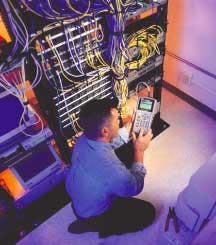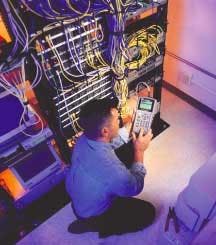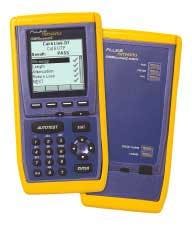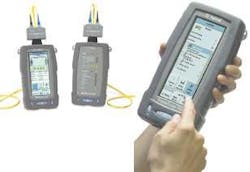Finding solutions for real-world Category 6 challenges.
The market for Category 6 cable testing solutions is shifting as contractors make their voices heard about the realities of working with Category 6 cable.
Contractors say some testing solutions are not allowing them to certify Category 6 cables that are terminated in a given way, and this feedback is sending some manufacturers back to the drawing board to revamp their products.
While most tester manufacturers provide equipment for testing Category 6 systems that use patch panels, only some now provide attachments necessary to test Category 6 cabling that use connecting block terminations.
But structured cabling solutions are increasingly using patch panels instead of ones that use connecting block terminations, and manufacturers say they are still determining whether they will make a tester that can test cable terminated to the blocks.
The major Category 6 manufacturers are: Fluke Networks (www.flukenetworks.com), based in Everett WA, Ideal Industries (www.idealindustries.com), based in Sycamore, IL, Agilent Technologies (www.agilent.com), based in Palo Alto, CA, and Tempo (www.tempo.textron.com), based in Rockford, IL. Some of these manufacturers are now revamping their products so they will be able to certify Category 6 systems that are terminated in all fashions.
"If a manufacturer did not offer that flexibility, it (the tester) would be at a disadvantage," says Bruce Nardone, a master instructor for BICSI.
Nardone and others see the testing landscape as uneven, and they suggest that manufacturers whose products won't answer all of their needs have got to step up to the plate. The bottom line, they say, is that there are a variety of testing solutions out there, and they're not all equal.
The players
In today's playing field, Fluke Networks and Ideal have testers that are capable of both forms of testing. Tempo has not determined if its new tester will be capable of certifying cable that has been terminated to connecting blocks, such as 110 blocks. Agilent Technologies, meanwhile, argues that its latest tester will surpass Fluke's in the testing arena.
Here's a breakdown of the products:
- Agilent Technologies makes the WireScope 350, a Category 6 tester introduced in November 1999 when Category 6 products were not even on the market. The company now is offering a tester that will also measure rates and response times of key network resources.
- Fluke Networks' DSP series or OMNIscanner series testers can test cables that are terminated to either patch panels or IDC blocks.
- Ideal Industries makes the LANTEK 6/7 and LT8XXX series LAN cable testers to support copper and optical-fiber certification. Both product lines can support block testing. With LANTEK's test and patch cord design, users can support block testing with commercially available RJ-45-to-block adapter cords. The LT8XXX testers have long supported block testing, but Ideal says it will soon be shipping its own Block Adapter Kit to make it easier for customers to do one-stop shopping.
- Tempo now offers the LANCAT 6, a tester designed to certify Category 5 or 5e systems. The company is currently designing a Category 6 certification tool that may be capable of both forms of testing.
Some manufacturing representatives say it is not surprising that testers are not all capable of testing the different types of terminations. Testers are still evolving, they say, just as Category 6 is only now becoming a growing presence in new-build terminations.
But the stakes are high. Hugo Draye, marketing manager for copper certification for Fluke Networks, estimates that one-third of the Category 6 cables being installed do not pass performance testing for one reason or another. Contractors require testers that will provide them with the answers they need, for all types of installations.
Testing challenges
Today's testing equipment must be extremely well-tuned to Category 6 parameters if it is going to help contractors accurately detect faults in a circuit. Nardone says manufacturers' test equipment must be able to test both cables that are terminated to connecting blocks and patch panels. "If they can't, they're at a disadvantage," says Nardone.
In the United States, Category 5e cable is still being installed frequently. But Category 6 cable is gaining fast, and manufacturers are the first to admit that they are more than a little challenged with coming up with testers that can handle the complications of Category 6.
"It's been a real technological challenge for us," says Draye. "To some extent, we are a little saddled with historic developments."
Some argue that the very nature of Category 6 cabling is forcing contractors to take a whole new, careful approach to installations. Standards for Category 6 testing also remain much tighter than for Category 5e, adding to the complexity.
"Category 6 has been evolving for the last several years, and we know that installers need to use the best practices in their copper terminations that they did with Cat 5 and 5e," says Ideal's Chen.
Interoperability is a key element with Category 6 installations. Both the cable and the connecting hardware must meet performance specs. And Category 6 cable in general is less forgiving than other copper cable.
"With Category 5 or 5e, we had more room for that margin of error," agrees Peter Desmarais, Agilent's business segment manager for communications solutions group. "But we don't have it as much with Category 6. From a testing standpoint, we have tighter tolerances."
For example, contractors who are working with Category 5e cable can tighten up a bend radius or pull a knot into it, untwist the knot, and still get the cable to pass. Not so with Category 6. The tolerance for near-end crosstalk for Category 5e cable is 13 db. For Category 6, the headroom is 9 dB. And TIA specifications point out that contractors should not strip back the cable jacket more than a half-inch.
"You have to follow those TIA installation practices, because with Category 6 you are working with much tighter limits," says Desmarais. "If it's not installed properly, it will fail."
Nardone recalls a time when he tested a Category 6 circuit from a patch panel—and it failed the return loss test. "I did a diagnosis of the cable circuit, and it showed up about 12 feet from the patch panel," says Nardone. "So, I looked out about 12 feet, and there was a tie wrap that was bundling the cable there."
Nardone says he checked the wrap to see if it was too tight, but it wasn't. He cut the wrap loose, loosened the bundle, and retested the circuit. This time, the installation passed the test. Nardone says the return loss the cable was experiencing was due to the weight of cables on the wrap, which probably would not have happened in a Category 5e system.
Cat 6 testing capabilities
Interoperability issues are making this complex issue all the more complex. Standards have defined what jacks look like, performance specs, and the development of a Category 6 plug—an eight-pin modular RJ-45 that is now a standard piece of test equipment. But today, manufacturers are still developing proprietary interconnect systems. Connecting blocks are a perfect example.
Different manufacturers are making products with different termination requirements, and contractors who are working with them must make adjustments in measurements as they conduct their tests.
Ideal does not offer manufacturer-specific adapters. The company instead advocates single-vendor matching plugs and jacks within Category 6 systems.
"The cable manufacturers are producing very fine Cat 6 cable today," says Chen. "In our lab, we have put various leading cable/connector manufacturers' cable through our bend, twist, knot tests, and it is incredible how the systems continue to perform at Cat 6 levels. For Cat 6 applications, the most critical area remains the plug and jack termination and compatibility."
Chen adds, "With out test with patch cord design, our customers can purchase commercially available adapter cords to meet their needs today. In addition, we are making the Ideal Block Adapter Kits available to make it easier for our customers to do one-stop shopping."
LANTEK and LT8XXX series testers are firmware/software-upgradeable products, which means users can download the latest features from the Ideal Web site, free of charge. Chen says Ideal has prepared for today's testing challenges by providing testers for both copper and optical fiber. More than half of the installations using Ideal products, she says, involve optical-fiber testing.
Agilent Technologies' WireScope 350 is a software-driven device that can be upgraded by the contractor, who can go to the Agilent Web site and download new commands. The tester is designed to provide support for all current and emerging LAN cable certification standards, including Category 6/Class E channel and permanent link.
The device has a 350 MHz test frequency range, and measurement accuracy beyond the draft TIA Level 3 specification. Its hardware exceeds the requirements for Category 6/Class E certification, and its vector network analyzer (VNA) design supports advanced calibration and diagnostic analysis capabilities.
Desmarais says WireScope has an interface that lets it be used for testing cable that has been terminated to both patch panels and IDC blocks. But the company now says it is surpassing Fluke Networks' product by offering the FRAMESCOPE that can provide full Category 6 certification and measure rates and response times for Web, e-mail print DNS and DHCP servers.
Of all of the companies, Tempo remains unconvinced of the demand for testing cable that is terminated to connecting blocks.
Peter Milstead, product marketing manager, points out that his division purchased Datacom Inc. in 1999. Tempo took over that company's line of testing products, which included the LANCAT 6, a Category 5e tester. The company is now designing the Category 6 tester, and the as-yet unnamed device is scheduled to be available in the second quarter of this year.
But Milstead says Tempo has not heard enough feedback to convince it that contractors are seeking testers that can provide the connecting block capabilities. "We have not determined if it will be a patch cord certification tester or an IDC block tester," he says.
"Our indication is that 66 and 110 blocks are a decreasing factor out there," says Milstead. "It's not primarily where we see the market requirements going today."
If there is confusion about Category 6 testing, Draye says this should not be surprising. He says the specs for Category 6 were not defined in a universal way until the final phases of products that were already in development. This meant that manufacturers were already putting Category 6 cabling and components on the market, even before the standard itself was completed. Problems were inevitable, he says.
"Until the standard came together, we had a full spectrum of individual pieces of connecting hardware," says Draye. "I'd need to buy patch cords that were terminated with plugs from someone else, and it would all have to mate together and give Cat 6 performance."
Brian Milligan is senior associate editor for Cabling Installation & Maintenance.



